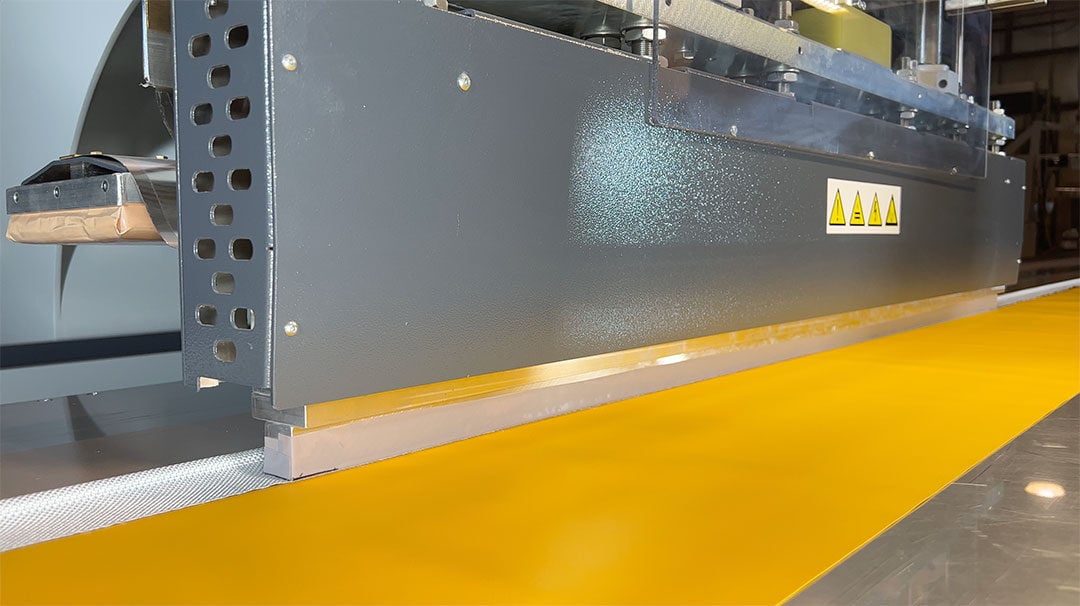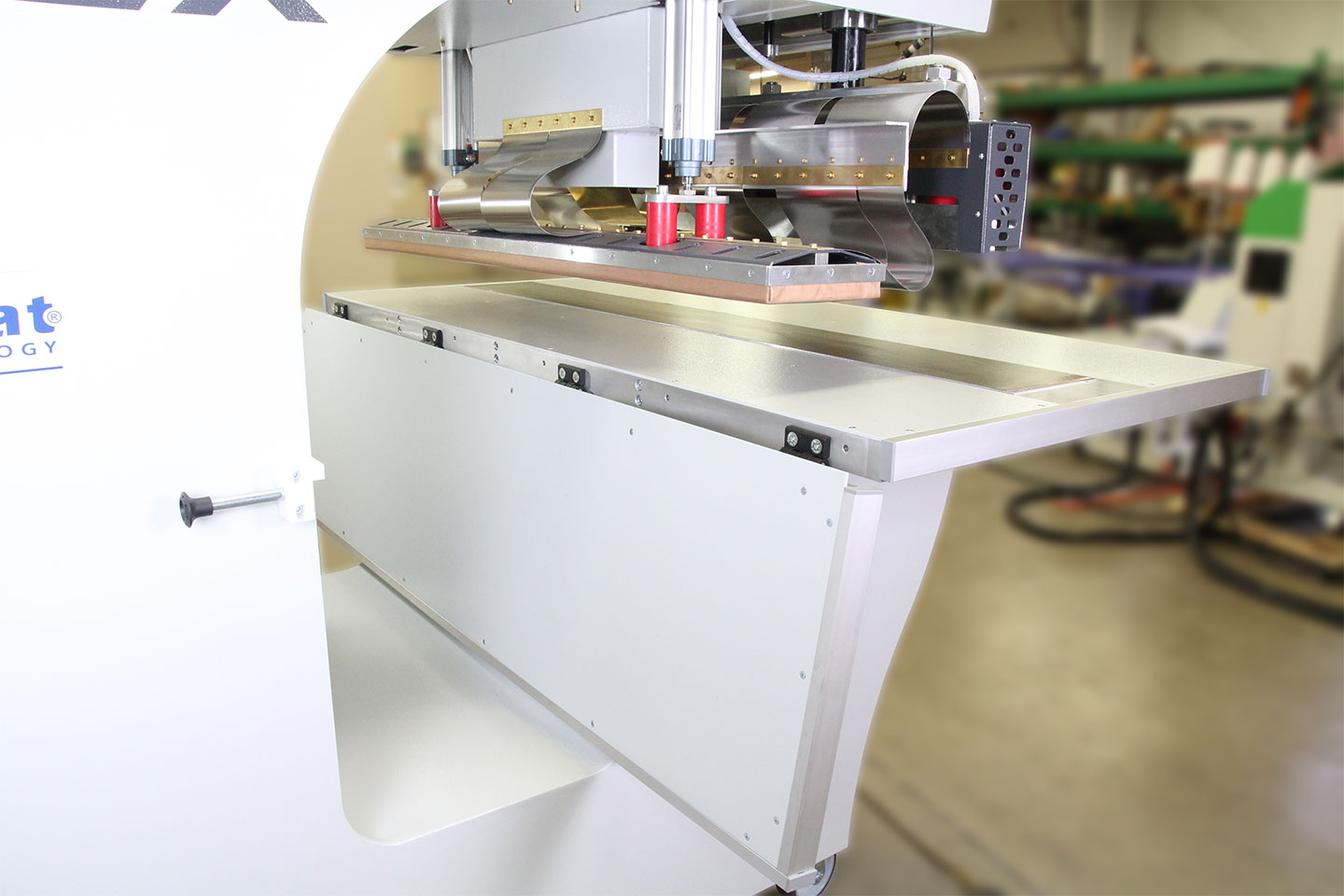Radio frequency welding, also known as RF welding, is a technology for manufacturers who need durable, airtight, and waterproof seams in industrial fabrics. Unlike other welding methods, RF welding generates heat internally, which provides unique benefits in terms of flexibility and strength, making it superior to alternatives like ultrasonic and hot air welding. Understanding how radio frequency welding works can help businesses in industries like inflatables, medical, pool liners, and more choose the right equipment to streamline production and improve product performance.
This guide is designed to help you navigate the different types of fabric welding machines, weigh RF welding vs hot air welding, and determine the best industrial welding solution based on your specific needs.
If you’re just starting your search or looking to upgrade, you’ll find valuable insights to help you choose the right equipment for your production line.
To learn more about the RF welding technology itself, visit our
Radio Frequency Welding Technology Page.
What Is Fabric Welding? A Quick Overview
Understanding the Purpose of Fabric Welding
Fabric welding is the process of joining thermoplastic materials together using heat, pressure, or electromagnetic energy. Unlike traditional sewing or stitching, which may leave tiny holes or weak points in the seam, welding creates weld seams that are exceptionally strong and durable, often surpassing the strength of the original material.
Benefits of fabric welding include:
-
Stronger, longer-lasting seams
-
Waterproof and airtight seals
-
Faster production with reduced manual labor
-
Clean appearance with no threads or perforations
Common Industries That Use Fabric Welding
Fabric welding is widely used across many industries that rely on flexible materials, including:
-
Inflatables (bounce houses, inflatable boats, air mattresses)
-
Pool liners and containment liners
-
Tents, tarps, and awnings
-
Medical products (blood pressure cuffs, IV bags)
-
Protective covers and military shelters
Explore more about fabric welding in the Inflatable Industry or the Pool Industry.
Overview of Fabric Welding Technologies
There are several types of industrial fabric welding equipment available, each suited for different materials, applications, and production goals.
Hot Air Welding
Hot air welding works by blowing heated air between two layers of thermoplastic fabric while applying pressure to bond them. It is ideal for thinner, flexible materials and general-purpose use.
Hot Wedge Welding
This method uses a heated wedge inserted between overlapping fabric layers. The pressure and heat create a fused bond. It works well with thick or coated materials and is perfect for long, straight seams and automated applications.
Impulse Welding
Impulse welding uses brief pulses of electrical current to heat and fuse thermoplastic materials. It's especially suitable for delicate, heat-sensitive materials like medical-grade films or fine textiles.
How Radio Frequency Welding Works
RF welding generates heat internally within the material using high-frequency electromagnetic waves. When the RF energy is turned off, the material cools, solidifying the bond formed during the welding process. When placed between two electrodes, the dielectric material (like PVC or polyurethane) reacts to the electromagnetic field, causing its molecules to oscillate and heat up. Specialized equipment is required for RF welding to generate and control the high-frequency electromagnetic energy. The material softens and bonds under pressure due to the high frequency energy and radio frequency energy applied.
Benefits of RF Welding:
-
Creates consistently strong, waterproof seams
-
Leaves a clean, professional appearance
-
Reduces thermal distortion, ideal for precision seams
-
Especially effective for PVC, PU, and thick coated fabrics
Learn more on our Radio Frequency Welding page.
How to Choose the Right Fabric Welding Machine for Your Business
Choosing the right welding technology depends on several factors:
Material Type & Thickness
-
Thin or heat-sensitive materials may require impulse or hot air welding.
-
Thicker or coated materials are better suited for hot wedge or RF welding.
-
Always test your material on different machines to determine weldability. You can send in a sample of your material and we will test it to ensure it welds properly.
Product or Application Type
Your product shape and functionality also matter:
-
Flat sheets (banners, covers) work well with hot air and hot wedge.
-
3D or tubular items (inflatables, ducting) benefit from RF welding.
Check out how RF welding is used in Inflatable Fabric Products.
Seam Requirements
Does your product require:
-
Airtight or watertight seams? RF welding is ideal for creating a watertight or airtight seal.
-
Cosmetic or structural seams? RF and impulse provide the cleanest seams.
Production Volume & Speed
-
Low-volume or custom jobs may be done manually.
-
High-volume production benefits from automated RF welding lines.
Operator Skill Level
Some machines require frequent setup and adjustment. Others, like advanced RF machines, feature intuitive interfaces that reduce the need for training.
Budget & ROI Considerations
-
Factor in not just the upfront cost, but also:
-
Machine lifespan
-
Energy efficiency
-
Repair/maintenance
-
Production throughput
-
In many cases, investing in a higher-end RF welder pays off long-term in productivity and reduced waste.
Why Choose RF Welding for Industrial Applications
Applications That Benefit Most from RF Welding
RF welding is particularly well-suited for applications requiring precision, durability, and seal integrity. These include:
-
Inflatables and life-saving floatation devices
-
Medical-grade fluid bags and blood pressure cuffs
-
High-pressure pool liners and bladder tanks
-
Military gear and field shelters
Key Advantages of RF Welding Machines
-
Strong seams: Internal heating ensures deeper, more complete bonding.
-
Consistent results: Repeatable, precise welds with minimal variation.
-
Material compatibility: Works with PVC, PU, TPU, and other dielectric materials.
-
No external heat: Reduces damage and distortion.
-
Professional appearance: Smooth, clean seams ideal for visible surfaces.
-
Consistent welds: Advanced technology and skilled technicians ensure strong and reliable welds across various applications.
Miller Weldmaster’s RF Welding Solutions
The RFlex Series for Industrial Use
The RFlex Series from Miller Weldmaster is engineered for high-performance RF welding across a wide variety of applications. Whether you're sealing inflatable structures or fabricating high-strength liners, the RFlex offers:
-
User-friendly touchscreen controls
-
Programmable settings for quick setup
-
Configurable options for automation
-
Precision weld arms for tight or complex geometries
Learn more about the RFlex.
How Weldmaster Supports Your Buying Decision
We understand that choosing the right equipment is an investment. That’s why our team offers:
-
Free material testing to ensure compatibility
-
Consultative support to match you with the right machine
-
Customer service and training to get your team up and running fast
Speak with our team to test your materials and find your best-fit solution.
Interested in learning more? Visit our RF Welding Technology Page and speak with a team member today
Frequently Asked Questions About RF Welding Machines
What materials can be used with RF welding?
RF welding works best with dielectric materials, including PVC, polyurethane (PU), and thermoplastic-coated textiles like TPU.
How does radio frequency welding differ from hot air welding?
RF welding heats the material from the inside out using electromagnetic energy, while hot air welding uses external heat blown between the fabric layers. RF provides stronger, cleaner seams. Compared to ultrasonic welding, RF welding offers superior flexibility and strength, making it more suitable for applications requiring durability and resistance to environmental conditions.
Is RF welding safe for sensitive materials?
Yes, RF welding is often safer for certain materials because it reduces direct surface heating and minimizes distortion.
What industries use RF welding the most?
RF welding is widely used in inflatables, medical manufacturing, military gear, automotive interiors, and waterproofing applications.
Can RF welding be automated for high-volume production?
Yes. Many RF welding machines, like the RFlex series, can be configured for fully automated operations, improving consistency and throughput.
What factors determine if RF welding is the right choice?
Key considerations include material compatibility, required seam quality, production volume, and application type.
How do I maintain an RF welding machine?
Routine maintenance includes cleaning electrodes, checking alignment, inspecting wiring, and ensuring consistent pressure and frequency settings.
How long do RF welds last compared to other methods?
RF welds are extremely durable, often outlasting sewn or hot air seams under high-stress or fluid-intensive conditions.
Are RF welders difficult to operate?
Modern RF welders are designed with user-friendly controls, but operator training is still important for optimal results.
How do I know which RF welder model is right for me?
Work with a manufacturer like Miller Weldmaster to test your material, understand your application, and determine the right machine configuration.




.png)